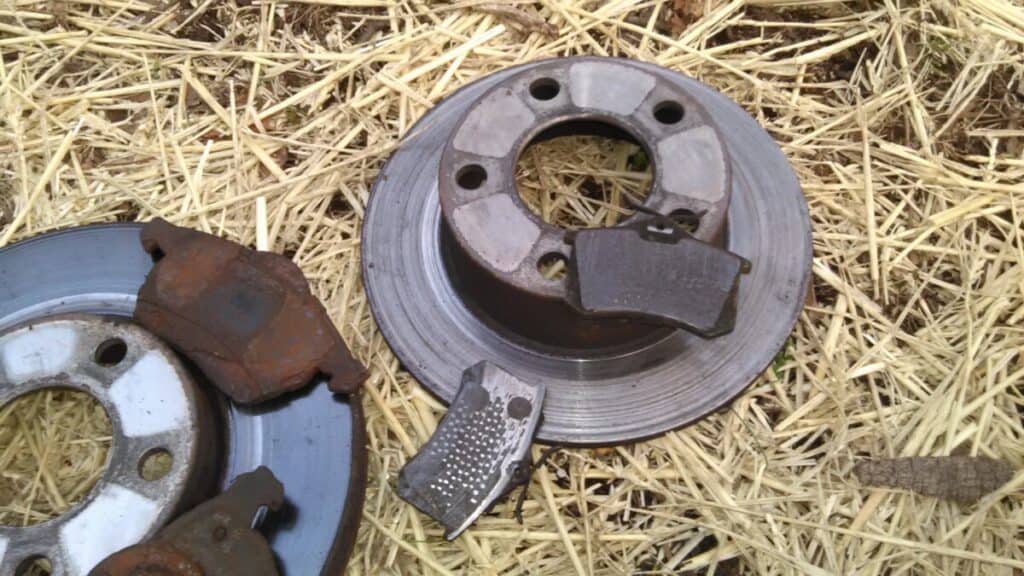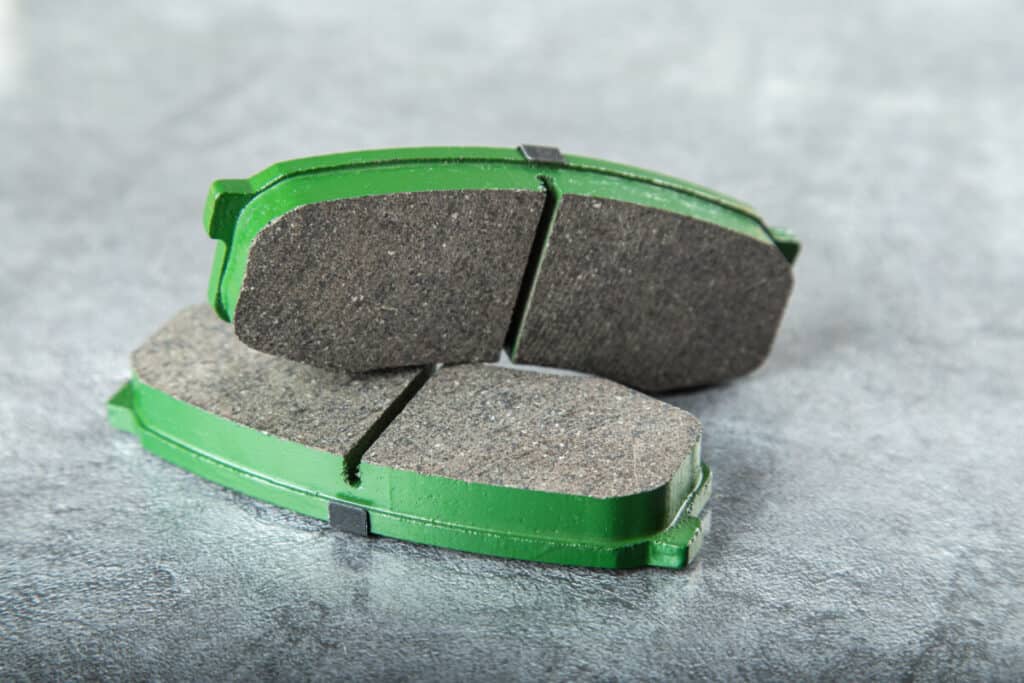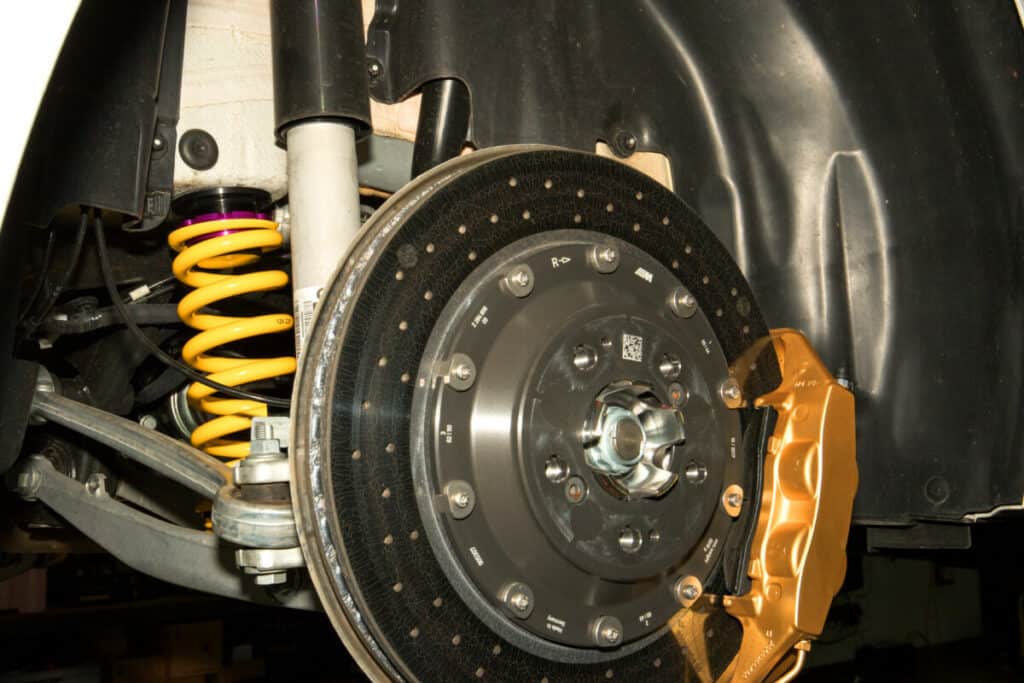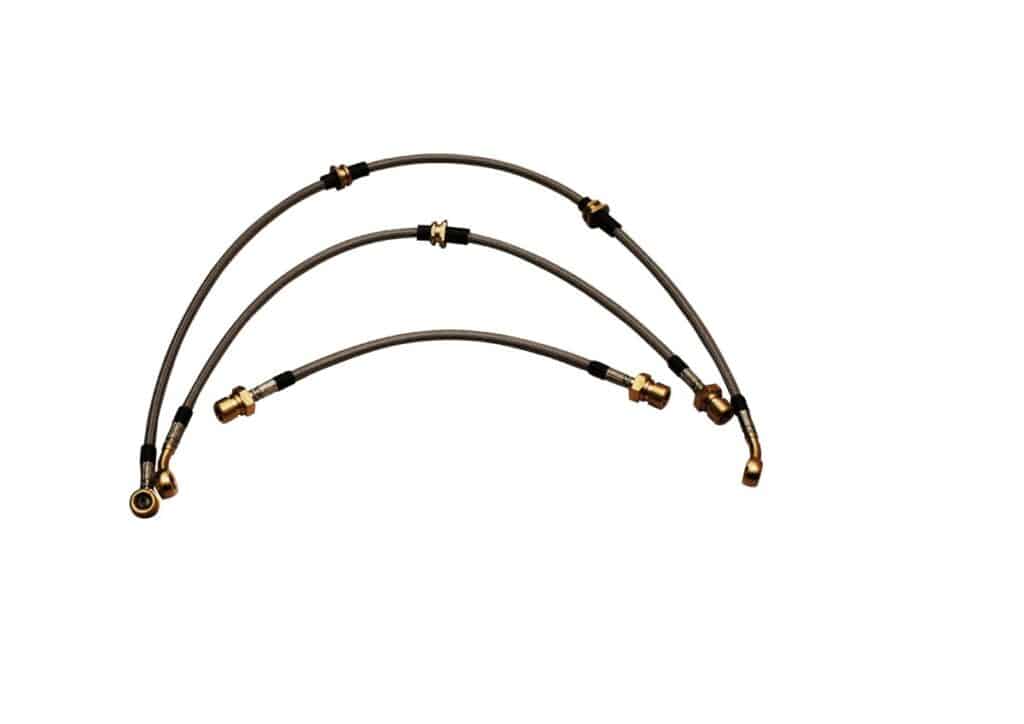
An important factor to consider when upgrading the performance of your car is your stopping power or brake responsiveness. After facing my own issues with brake fade, I discovered the importance of braking performance and the best methods of improving brake responsiveness with a few simple steps.
- Replace brake pads and rotors (Discs)
- Drain out the old brake fluid and replace it with fresh fluid
- Use high-performance brake fluid
- Upgrade your brakes to ceramic pads
- Upgrade to drilled and grooved disk brake rotors
- Install steel braided brake lines
Replace Brake Pads and Rotors
If its more responsive brakes you want, the first thing to do would be to replace the old brake pads and rotors with new ones.
Brakes on a car work by creating friction between the brake pad and the surface of the rotor when you press on the brake pedal.
This happens due to high-pressure brake fluid being pushed from the master cylinder, through the brake lines which then forces a piston inside the brake caliper to squeeze your rotor between both brake pads. Needless to say, this would be very consuming on a material i.e. your brake pads and rotors.

That’s why it’s advisable to check/replace your brake pads every second service, if you service your car every 10,000 miles, due to manufacturers estimating an average lifespan of brake pads to be between 20,000 and 65,000 miles.
Once the pads and rotors become worn they decrease in width which results in more pedal travel when you press on the brake pedal, this is because the piston in the brake caliper needs to travel further to make the pads squeeze the rotor.
Replacing your brake pads and rotors is always a smart thing to do plus you get the advantage of more responsive brakes. New brake pads will set you back about $30 and can be easily replaced yourself by following along with this in-depth step-by-step guide iv written on how to replace your brake pads and rotors.
Benefits of Replacing Your Brake Fluid
When brake fluid gets old it deteriorates, causing what’s known as brake fade, this is when you feel the brake pedal gradually sinking further down to the floor than it normally should without having the same stopping power.
The reason for this is because brake fluid is hygroscopic, meaning it can absorb from 1 to 2% of water per year, which then lowers its boiling point.
Once the brake fluid begins to boil, air bubbles are created in the fluid, causing the fluid to compress when you hit the brakes, rather than a hard solid brake pedal, it will feel spongy and sink gradually further than normal.
This is an excellent video with experiments showing the effects that water can have on brake fluid.
Unfortunately brake fluid is not something that ever really gets changed when your car is getting a service, largely because the owner is not aware of it needing to be changed. Iv worked on 20-year-old cars that have never gotten the brake fluid replaced, once I replaced the old gunk for fresh fluid the brakes were completely transformed and more responsive than ever.
If you think your brake fluid might be ok but your not 100% sure, there are these really handy brake fluid test strips (Amazon link) you can get to test the condition of your brake fluid without even taking off a wheel. If your brake fluid is beginning to deteriorate it is definitely worth getting it replaced.
When you replace your brake fluid you will be faced with a couple of options of which brake fluid to choose from, so you need to be familiar with their properties to choose the correct one.
Dot3 brake fluid has the lowest wet boiling of 284 degrees Fahrenheit, which is perfect for most daily cars but it will have a shorter lifespan and lower performance at high speeds due to a lower boiling point, to begin with.
Dot4 brake fluid has a slightly higher wet boiling point of 338 degrees Fahrenheit and would be more suitable for those who want more performance and better responsiveness (for longer) from their brakes.
Dot5 brake fluid has a wet boiling of 360 degrees Fahrenheit and is similar to Dot4 except Dot5 is silicon-based and should only be used if recommended by the car manufacturer.
Dot3 and Dot4 are interchangeable.
Use Performance Brake Fluid For More Responsive Brakes
A lot of people ask the question, “but is there even a difference?”, well the answer is 100% YES. The next question is do you actually need it?

The difference between Super Dot4 performance brake fluid and Dot4 is that Super Dot4 has a wet boiling point of 509 degrees Fahrenheit, compared to Dot4 having a wet boiling point of 338 degrees Fahrenheit. The fluid with the lower boiling point will boil faster creating air bubbles in the fluid causing pedal fade.
Super Dot4 (Amazon link) is a huge advantage on the track when your brakes are under intense pressure at high speeds. After two laps around the track using standard brake Dot4 brake fluid in my DC2 Integra, the brake fluid would begin to boil causing scary brake fade.
After I switched to Super Dot4 I had very little brake fade, any that I still had was fixed once I upgraded my pads to ceramic.
For the majority of people in daily cars, it’s generally not needed. The advantage to using Super Dot4 in a daily car is that it will have a much longer lifespan because it will take the water being absorbed into the fluid much longer to lower the boiling point of the fluid to a point where it is unsafe or a spongy brake pedal.
Upgrade Brakes to Ceramic Pads
When I upgraded my brakes it completely transformed how the car drove and performed, both on the road and on the track. The brakes were more responsive than ever even after a hard track day.

Stock brake pads are made of organic material, which means it contains less than 30% metallic material. Organic brake pads usually consist of Carbon, Kevlar, glass, and rubber which are then bonded together using a resin bonding agent, which then forms the brake pad.
The downside to organic brake pads is that they produce a lot of black carbon brake dust which is very hard to wash off the wheels and some organic brake pads still contain small amounts of asbestos.
Another downside to stock organic brake pads is under hard braking they heat up very quickly causing huge amounts of brake fade and if you continue to aggressively use the breaks the pads will eventually break apart, causing complete brake failure.

The benefits of upgrading to ceramic brake pads are there is virtually no brake dust produced from the pads, along with the fact that you will experience zero brake fade under any type of driving conditions.
Ceramic brake pads handle heat extremely well due to being made from a non-heat conducting ceramic material.
Ceramic pads are also a hard and long-wearing material, meaning they will not wear out quickly even under extreme braking, a caveat to that is that they are surprisingly non-wearing on the brake rotors, unlike semi-metallic brake pads which are extremely hard wearing on brake rotors.
Another benefit of using ceramic brake pads vs organic or semi-metallic is that they produce zero noise or squealing due to being made from such a light material, making it virtually impossible to create noise at the resonant frequency of human hearing.

When you are choosing which ceramic pads to buy the most important thing to remember is to buy from the most reputable trusted brands.
Because ceramic brake pads are relatively new and the most technologically advanced brake pads on the market plus the most expensive to produce, there are a lot of cheaper brands producing low-quality brake pads to try to bring down the end price, but they are sacrificing performance for profit.
Cheaper ceramic pads tend to not bite as well in cold conditions, whereas TRW(Amazon link) is a well-established brand with over 100 years of experience that guarantees quick brake responsiveness and ultimate stopping power while still producing very very little dust or wear on the pads or rotors.
Upgrade to Drilled and Grooved Disk Brake Rotors
The brake rotors that come on 99.96% of the cars manufactured worldwide are smooth rotors, which means they have a completely smooth flat surface.
This suits most drivers’ daily needs but the downside to smooth rotors is that they cannot expel the heat produced from extreme braking quickly enough, causing brake fade and eventually warpage of the rotor.

Under extreme driving conditions, the rotor heats up due to kinetic energy and friction between the pads and the steel rotor.
This heat produces a gas which then creates a barrier between the brake pads and the rotor causing the pads to float on the disc. This along with the heat is the reason brake fade occurs and you may feel like the car is not stopping as fast as it should and the pedal will feel spongey.
The benefits of installing drilled and slotted rotors(Amazon link) are that heat can dissipate much faster because of air circulation through the rotor.

Another important advantage is that the slots and holes allow the gas build-up to escape without creating a barrier between the rotor and pad, eliminating brake fade and significantly improving brake responsiveness.
Drilled and grooved rotors are a very worthwhile upgrade for both road and track use if you want to make your brakes more responsive, the only downside is that they are a little bit more consuming on brake pads due to having slots and holes wearing off the pad rather than a smooth surface.
Install Steel Braided Brake Lines
If you want to make your brakes more responsive upgrading your brake lines from stock rubber lines to Steel braided brake lines will noticeably improve your braking performance, especially under extreme driving conditions.
Stock brake lines are made from Nitrile rubber which is a tough durable material. The downside to using rubber brake lines is that once you subject the car to hard braking conditions the brake fluid will heat up, especially if you’re not using high-performance brake fluid.

Once the brake fluid gets hot the rubber brake lines then begin to slightly soften, making them more expandable. This means that when you press hard on the brake pedal instead of the brake fluid exerting maximum pressure on the piston in the brake caliper it instead begins to expand the rubber brake lines.
The amount of expansion that takes place is on a microscopic level, but still, every little bit counts when you are trying to increase the responsiveness of your brakes.
The benefit of upgrading to steel braided brake lines is that they are designed not to expand under any driving conditions while also being far more resistant to wear and abrasion.

Steel braided brake lines are made up of four layers: The Teflon core which is a highly durable, self-lubricating, material that has the third-lowest coefficient of friction of any other solid.
Covering the Teflon core is a protective layer that sits between the steel braid and the Teflon to protect the Teflon from damage caused by the stainless steel braid. There is then another protective lacquer coating applied over the steel braid to seal it from the elements.
The difference between rubber brake lines and steel braided brake lines is surprising when you compare the thermal expansion temperature of both Nitrile rubber and Teflon, with Nitrile rubber having a thermal expansion temperature of 140 degrees Celsius and Teflon having a thermal expansion temperature of 325 degrees Celsius.
This means that if you use Dot3 brake fluid under extreme driving conditions it will eventually reach its wet boiling point of 137.7 degrees Celsius, which will then cause rubber brake lines to reach their maximum thermal expansion rate of 140 degrees Celsius, causing the brake lines to expand rather than exert full pressure on the brake pads and rotors.
This along with being covered by a steel braid guarantees there will be absolutely no expansion of the brake line under any condition.

So if it’s more brake responsiveness you want, steel braided brake lines(Amazon link) will help you achieve better braking performance during extreme braking conditions.
The people who will get the most benefit from braided brake lines are those who drive aggressively with hard braking such as on the track when the brakes will be hot for a long period but another plus side is they look cool and will resist wear and abrasion much longer than the rubber brake lines will.
Recent Posts
As much as I and everyone else love turbochargers there is one problem most people have with using them, turbo lag. Turbo lag is a hesitation or unresponsiveness which may be felt as a slow...
Last week a friend of mine arrived in my shop with a Garrett 3076R turbocharger and asked me if I could install it in a stock Miata MX5 because he wanted to more power out of corners on the track....

